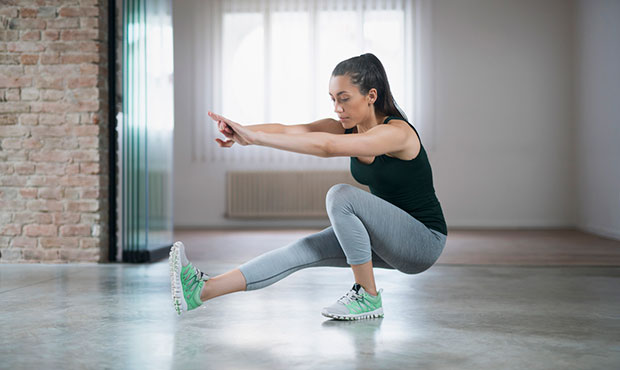
There are two good reasons to turn your workout into a balancing act. First, a controlled wobble activates deep core muscles to help tighten the midsection. Secondly, it prepares athletes for that quick turn or lunge.
When performing exercises to improve balance, it is important to engage your abdominals by tightening them—without holding your breath—as if preparing to take a punch. You'll activate the core muscles surrounding your spine and tone your entire abdominal area. Engaged abs also help prevent injury when lifting.
If you have a medical condition, be sure to check with your doctor before trying these balance exercises or any new fitness program.
Exercises to Improve Balance
You need balance to perform just about any task, from walking, to standing, to sitting down in your chair. Improving your balance isn’t just important for working out, it is also important for maintaining quality of life and avoiding pain. Plus, knowing how to brace your core correctly in the gym and having good balance during explosive movements will prevent injury and help you get the most out of every workout.
Use these balance exercises to improve your balance and core strength.
1. One-Legged Balance Exercise
Start with this beginner's move, keeping a stable chair or a wall within an arm's reach. With feet together, pick up one foot with the knee facing forward or to the side. Hold the position with eyes open, then closed. Switch feet and repeat for four reps on each foot.
If any move feels wrong or unsafe to you, stop and check with a trainer. Depending on your health and physical condition, some exercises may not be recommended.
2. Leg Swings
Stand on your right leg and raise the left leg three to six inches off the floor. With arms at your sides, swing your left leg forward and backward, touching the floor for balance, while keeping your torso erect. Now, repeat the move, but don't allow your foot to touch the ground. And finally, swing the left foot to the left side, holding the right arm out. Switch legs and repeat.
3. One-Legged Clock Balance Exercise
Balance on one leg, with the torso straight, head up and hands on the hips. Visualize a clock and point your arm straight overhead to 12, then to the side at three, and then circle low and around to nine without losing your balance.
Increase the challenge by having a partner call out the different times to you. Switch to the opposite arm and leg and repeat.
4. Balance Exercises on an Unstable Surface
Once you master balance moves on solid ground, try them on an unstable surface such as a BOSU platform. Stand near a wall or other support, for safety. Start in the middle of the board on two feet. When you feel comfortable, carefully give the one-legged clocks a try. It's harder than it looks.
If you don’t have a BOSU platform, try finding an unstable surface, like a floor pillow or even your bed to stand on.
5. One-Legged (Pistol) Squats
Stand with your feet hip-width apart. Point your left foot out front, just barely touching the floor for balance, and push your hips back and down into this challenging one-legged squat position. Your right knee should be bent, chest upright, eyes forward and your arms out front. Slowly push up to return to a standing position. Switch feet. Be sure the knee doesn't push past your toes.
6. Single-Leg Romanian Dead Lift (RDL)
Balance on your left foot, engage the abs, and hinge forward at the hips while reaching toward the ground with your right hand. Your right leg should stay off the ground and extend out behind you as a counterbalance. Tighten your buttocks and core to return to a standing position. Keep your knees relaxed and your back flat throughout the movement. Switch legs.
Once you’ve got the hang of the movement, add some weight. Hold on to a 5- or 10-pound dumbbell with the hand opposite of the leg you are balancing on.
7. Tools and Toys for Balance Exercises
Challenging your balance may be as simple as standing on one leg or closing your eyes. But for added challenge and fun, include balance boards, balance cushions or sturdy foam rollers.
Keep safety in mind at all times: remove objects around you and stand near a wall or stable surface in case you lose your balance.
READ THIS NEXT: 15 Workout Milestones Every Fit Person Should Reach
 Stay in shape in a fitness class or read more fitness articles.
Stay in shape in a fitness class or read more fitness articles.
Balance Exercise FAQs
How often should you perform balance exercises?
You can do balance exercises every day or as often as you’d like. Because they are low-impact, controlled movements, there’s not really any risk of over-training. Older adults who are at risk of falls should try to do balance training at least three times a week to reduce risk.
How long does it take to see results from balance exercises?
Training your balance three to six times each week should start to show results in 11 to 12 weeks. So, if you perform these exercises multiple times a week you should see improvements in your balance in as little as three months.
How long should you hold balance exercise positions?
The key to successful balance exercises is control and form. Move slowly with intention, focusing on bracing your core. Moving quickly will actually be less effective for these exercises. For the movements that require a hold, try to hang on for at least 30 seconds, increasing each week as you improve.


